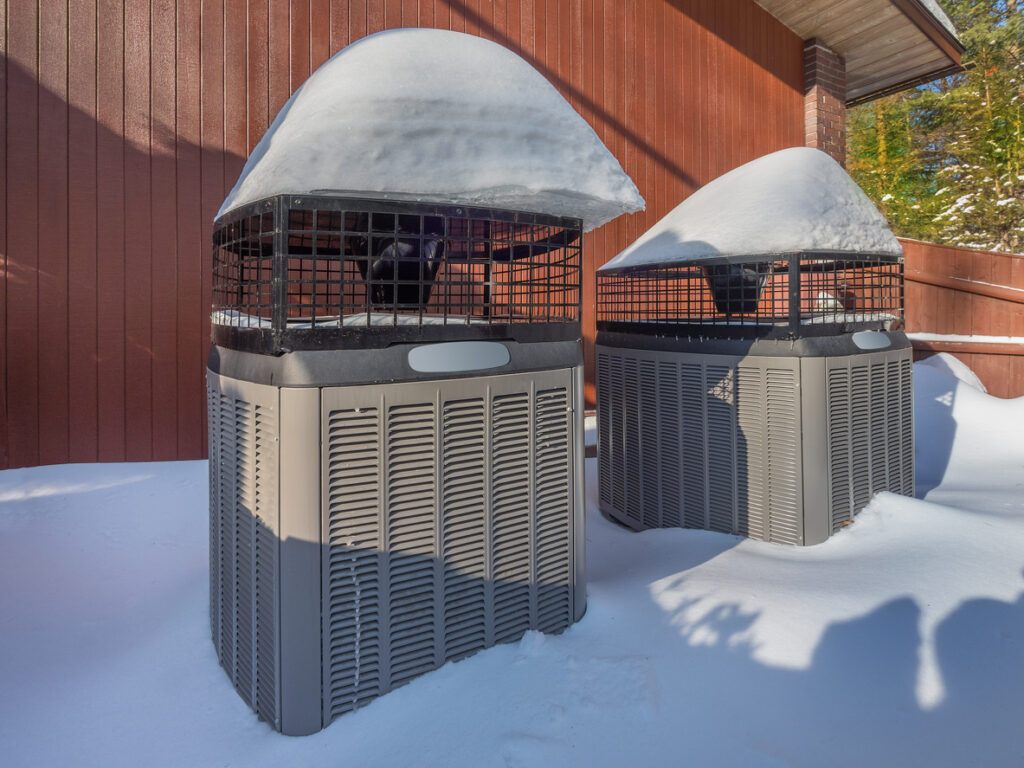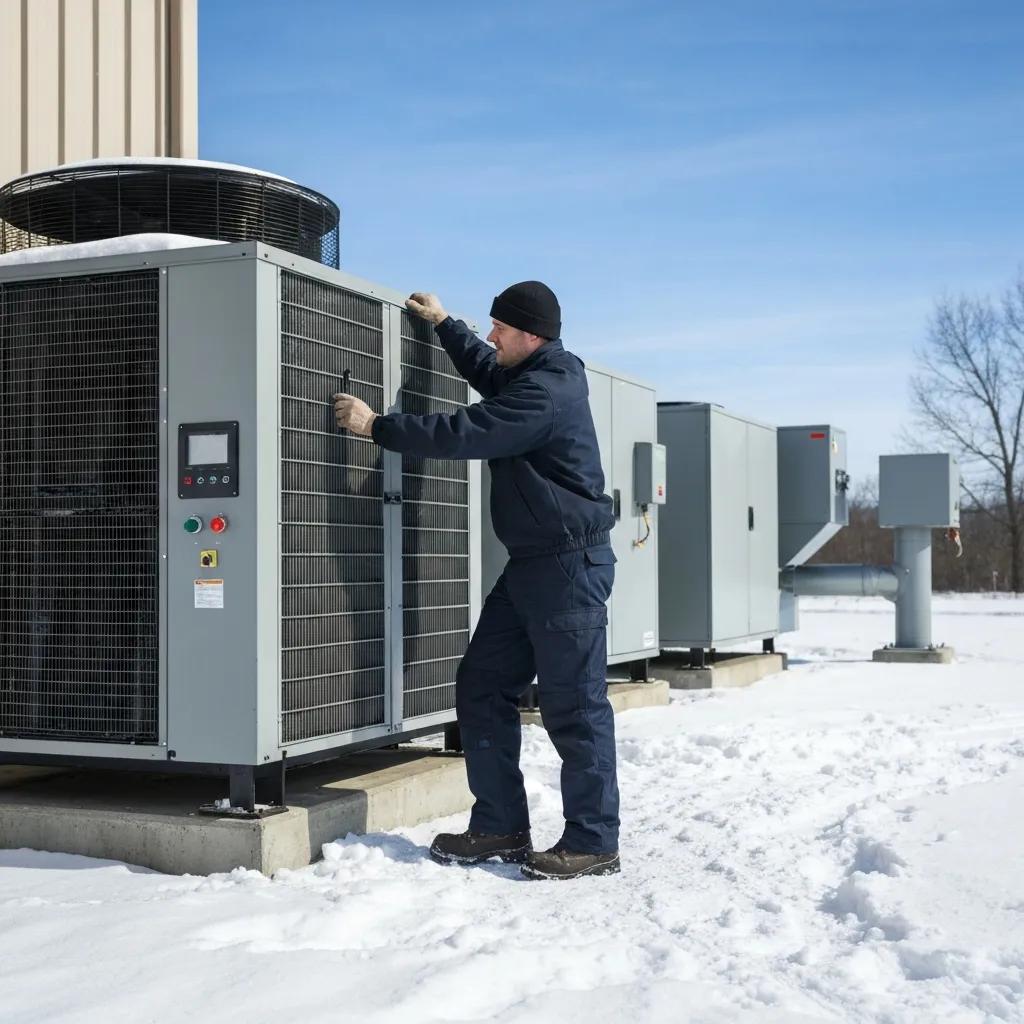Winter-Ready: Commercial & Industrial HVAC Checklist and Practical Tips

Winter HVAC covers the inspections, adjustments, and protective steps that keep commercial and industrial heating systems safe and reliable through cold weather. This guide shows facility managers across Central Massachusetts and New England why proactive winter maintenance cuts downtime, lowers fuel and energy costs, and protects plant assets from freeze damage and heavy heating loads. You’ll get step-by-step preparation checklists, furnace and boiler winterization procedures, pipe and valve insulation guidance, and control strategies aimed at commercial and industrial systems. We also call out emergency symptoms, outline rapid-response priorities, and explain how regular service extends equipment life and preserves continuity. Read on for clear checklists, quick-reference tables, and decision points you can use before temperatures fall and heating demand spikes.
How to Prepare Commercial HVAC Systems for Winter
Preparing commercial HVAC for winter means running a coordinated set of inspections, controls checks, and physical protections so rooftop units, boilers, furnaces, and ductwork stay dependable during extended cold. Effective preparation focuses on airflow, combustion performance, control calibration, and weatherproofing so systems deliver required heat while reducing freeze-related failures. The best campaigns mix routine in-house tasks with scheduled professional inspections completed before peak season. Below is an ordered checklist facility teams can implement right away.
Key Steps in a Commercial HVAC Winter Maintenance Checklist
A short, operational checklist helps facility teams prioritize work and assign responsibility between in-house staff and contractors. Start with airflow and filtration: replace or upgrade filters to the MERV level your equipment requires, inspect belts and bearings for wear, and lubricate blower motors per manufacturer guidance—these steps restore capacity and reduce electrical draw. Next, confirm controls and sensors: calibrate thermostats and BAS setpoints, test safeties and interlocks, and log calibration results for trend tracking. Finish with outdoor protections: clear debris from condensing units, secure loose panels, add recommended weather guards for exposed rooftop equipment, and verify curb seals to prevent infiltration and water damage. Following this sequence helps you schedule contractor windows and build sensible contingency plans.
Below is a quick reference table to help teams scan components, actions, and suggested frequencies so planners can allocate labor and contractor time efficiently.
| Component | Required Action | Recommended Frequency/Notes |
|---|---|---|
| Air Filters & Vents | Replace or upgrade filters; inspect grilles and dampers | Monthly during heavy use; record filter MERV rating |
| Belts, Motors & Blowers | Check alignment and tension; lubricate bearings | Quarterly: pre-winter and mid-winter checks |
| Controls & Thermostats | Calibrate setpoints; test sensors and safeties | Pre-winter and after major service events |
| Rooftop/Outdoor Units | Clear debris; secure panels; install wind/weather guards | Pre-winter and after storms |
When to Schedule Professional HVAC Inspections

Book professional inspections before occupancy patterns and heating demand peak—while outdoor temperatures are still moderate and contractors can access roofs and equipment without weather delays. Larger facilities or sites with redundancy requirements should reserve earlier slots and allow lead time for parts and outage windows; coordinate work for off-peak hours to limit disruption. Bring in technicians immediately for red flags like unusual combustion odors, repeated sensor errors, or systems that can’t hold design setpoints. Establishing standing inspection windows and escalation triggers reduces unplanned downtime and supports winter continuity planning.
If an inspection uncovers work beyond in-house scope—combustion tuning, control rewiring, or complex duct repairs—hire qualified contractors and document the repairs for compliance and warranty purposes.
Morris Mechanical supports commercial inspection and maintenance plans for facility operators across Central Massachusetts and New England. We offer targeted professional inspections and follow-up service scheduling to help businesses implement the checklist above with minimal disruption and improved winter readiness.
Best Furnace Winter Maintenance Tips for Businesses
Furnace winter maintenance for business-grade systems is about keeping combustion efficient, venting safe, and airflow consistent so heating loads are met without wasting fuel. Proper maintenance lowers breakdown risk, prevents carbon monoxide hazards, and keeps capacity steady under the continuous duty cycles common in commercial settings. Start with combustion and airflow balance, then move to electrical and safety device checks, and finish by documenting baseline performance so you can spot drift over the season. The next section lists preventative tasks technicians and in-house staff can perform to keep systems running efficiently.
Preventative Furnace Maintenance for Winter Efficiency
Begin with filters and airflow: change commercial filters to the design MERV level and inspect the blower wheel and housing for dust or buildup that reduces heat transfer. Perform combustion analysis on gas-fired units to verify burner tuning, flame characteristics, and combustion efficiency—correct adjustments save fuel and extend component life. Inspect ignition systems, pilot assemblies, and control relays for wear; tighten electrical connections and confirm motor amperage matches nameplate values. Completing these steps establishes an efficiency baseline and lowers the chance of mid-season failures that interrupt operations.
Good recordkeeping of preventative work enables trend analysis and earlier detection of declining performance—insights that feed into the safety checks covered next.
Use this short prioritized list for daily or weekly walkthroughs by facility staff.
- Visual Combustion Check: Look at flame color and venting for soot or discoloration.
- Airflow Walkthrough: Verify supply diffusers are delivering warm air as expected.
- Control Status Review: Confirm thermostat schedules and any overrides.
These quick inspections catch developing issues early and support scheduled professional service.
Essential Safety Checks for Furnace Winter Readiness
Safety checks protect occupants and verify combustion integrity during heavy winter use. Inspect the heat exchanger for visible cracks or corrosion and perform combustion testing to detect incomplete combustion and elevated CO risk—any sign of exchanger compromise requires immediate shutdown and professional assessment. Make sure venting paths are clear and combustion air supply meets manufacturer requirements, particularly after building envelope work. Test CO detectors and alarms in occupied zones and verify interlocks and emergency shutdowns function correctly to meet safety and code requirements.
If safety checks reveal concerning conditions—persistent CO readings, heat exchanger damage, or blocked venting—relocate occupants or isolate zones until repairs are completed. That’s when you should escalate to professional furnace repair or replacement services.
Morris Mechanical provides furnace repair, service, and replacement for business clients. Facility managers can request a quote when inspection findings exceed in-house capabilities to ensure safe, compliant operation throughout winter.
How to Winterize Industrial Heating Systems Effectively
Industrial winterization applies technical, process-level protections to boilers, heat exchangers, pumps, and distribution piping to prevent freeze damage, preserve thermal efficiency, and maintain process continuity. The program combines inspection, water treatment, mechanical protection, and redundancy planning so critical processes stay within temperature tolerances. For industrial operators, winterization also covers fuel supply planning, control redundancy, and scheduled testing of safety interlocks. The following subsections break down boiler and exchanger tasks plus piping insulation strategies that deliver measurable uptime and efficiency gains.
Critical Winterization Steps for Boilers and Heat Exchangers
Boiler winterization starts with a detailed pre-season inspection to verify burner performance, safety controls, and feedwater chemistry—proper treatment prevents corrosion and scaling that reduce heat transfer. Clean heat exchanger surfaces and tubes to remove fouling, perform full safety interlock testing, and validate pressure relief devices and low-water cutoffs. For intermittently used systems, use controlled warm-up sequences and watch for signs of thermal shock that stress tubes. Document baseline operating parameters after winter commissioning so operators can detect deviations that indicate maintenance needs.
These steps improve reliability and help quantify energy benefits that justify winterization investment. Below is an easy table mapping common winterization tasks to expected outcomes for industrial systems.
| System Component | Winterization Step | Expected Outcome |
|---|---|---|
| Boiler Controls | Test and calibrate safeties and interlocks | Lower trip risk and safer operation |
| Heat Exchangers | Mechanical cleaning and flow testing | Restored heat transfer and efficiency |
| Feedwater Treatment | Adjust chemistry and change filters | Reduced corrosion and scaling |
| Redundancy Systems | Validate backup boilers and pumps | Continuous process uptime during failures |
How Pipe and Valve Insulation Prevents Winter Damage
Proper insulation preserves process temperatures, prevents freezing, and cuts heat loss that drives up fuel use. Choose insulation by temperature, exposure, and mechanical wear: closed-cell elastomeric foam works for moderate outdoor lines, mineral wool with jacketing suits high-temperature steam, and heat-trace systems with thermostatic controls are essential for intermittent-flow or exposed lines. Install insulation carefully—seal joints, cover valves and flanges, and inspect periodically for compression or gaps that reduce effectiveness. ROI comes from avoided freeze repairs, fewer process interruptions, and lower fuel costs from reduced thermal loss.
Keep inspection records and install temperature sensors at representative points to verify insulation and heat-trace performance. Those data support ROI tracking and preventive maintenance planning.
Energy-Saving Winter HVAC Tips to Lower Business Heating Costs
To reduce winter heating costs sustainably, combine smarter controls, envelope improvements, and diligent maintenance. Optimize thermostat schedules and integrate programmable or smart controls with your building automation to cut unnecessary runtime during unoccupied periods while keeping comfort when needed. Pair controls with targeted envelope upgrades—air sealing, insulation, vestibules—to shrink heating loads and improve system cycling. Regular maintenance keeps equipment near nameplate efficiency and amplifies savings from controls and envelope work. The sections below compare thermostat options and outline high-impact envelope measures.
How Programmable and Smart Thermostats Improve Winter Efficiency
Programmable and smart thermostats reduce wasted runtime by enforcing setbacks, managing adaptive recovery, and integrating with a BMS for zone-specific strategies. Programmable units use fixed schedules for occupied and unoccupied periods; smart controllers add learning algorithms, remote monitoring, and demand-response features to react to real-time conditions. Properly configured setback strategies yield measurable heating savings depending on occupancy and control fidelity; pairing controls with regular maintenance multiplies benefits. When integrated with a BMS, you gain alarms and analytics that help operations refine setpoints and sustain energy savings.
When selecting thermostat technology, prioritize compatibility with existing controls, required communication protocols, and the ability to produce actionable energy reports for continuous optimization.
Use the table below to compare technology attributes and business benefits during decision-making.
| Technology | Attribute | Business Benefit |
|---|---|---|
| Programmable Thermostats | Fixed schedules | Immediate setback savings during unoccupied hours |
| Smart Thermostats | Adaptive learning and remote monitoring | Ongoing optimization and analytics-driven savings |
| BMS Integration | Centralized control and alarms | Better coordination of HVAC, ventilation, and energy use |
| Heat Recovery/ERVs | Sensible and latent heat recovery | Reduced heating load and improved indoor air quality |
When to Call for Emergency Winter HVAC Repair
Certain symptoms demand immediate response because they risk occupants, processes, or equipment. Emergency signs include total loss of heat in critical spaces, persistent carbon monoxide alarms, gas odors, major leaks threatening electrical or process gear, and control failures that prevent safe shutdowns. If these occur, follow your mitigation steps: evacuate or isolate affected areas, shut off fuel sources if it’s safe, and activate emergency service protocols. The next sections list common winter breakdowns and quick diagnostics, then describe Morris Mechanical’s emergency approach.
Common Winter HVAC Breakdowns in Commercial and Industrial Facilities
Typical winter failures include frozen condensate or drain lines that cause backups, ignition and burner faults that stop heat production, and control or sensor problems that trigger unwanted shutdowns. Frozen pipes and valves can burst and cause flooding with long repair lead times, while fouled burners or incorrect combustion settings reduce output and raise carbon monoxide risk. Quick diagnostic tips for facility staff: confirm power and fuel availability, listen for abnormal combustion sounds, and check condensate and drain paths before calling for service. These checks can identify simple fixes and decide whether an emergency dispatch is needed.
Document symptoms and recent maintenance history promptly—this speeds triage and helps responders bring the right parts and tools on the first visit.
How Morris Mechanical Handles 24/7 Emergency Heating Repair
Morris Mechanical provides around-the-clock emergency heating repair for commercial and industrial clients, focusing on rapid triage, prioritized dispatch, and temporary mitigation to protect occupants and processes until permanent repairs are completed. Our field teams stabilize conditions—temporary heat, leak isolation, control bypasses—then schedule planned follow-up repairs with full documentation to return systems to normal. If you have an emergency, follow internal safety protocols and contact our emergency channels to request prioritized support. Our response model minimizes downtime and coordinates closely with facility operations for safe, efficient access and repairs.
Frequently Asked Questions
What are the signs that my commercial HVAC system needs immediate attention during winter?
Immediate attention is required for a total loss of heat in critical areas, persistent carbon monoxide alarms, a strong gas odor, or major leaks that threaten electrical or process equipment. Systems that won’t respond to thermostat commands or make unusual noises can also indicate serious faults. Address these symptoms quickly to protect occupants and operations.
How can I ensure my HVAC system operates efficiently throughout the winter?
Combine regular maintenance, proper insulation, and smart controls to keep systems efficient. Schedule annual tune-ups for combustion checks, filter changes, and control calibration. Insulate pipes and valves to prevent heat loss and freezing. Use programmable or smart thermostats to tighten heating schedules around occupancy. These steps reduce energy use and extend equipment life.
What should I do if I notice unusual smells coming from my HVAC system?
If you smell gas or a burning odor, evacuate the area and ensure occupants are safe. If it’s safe and you’re trained to do so, shut off the gas and call emergency services. For burning smells without gas, shut down the system and contact a qualified technician immediately. Don’t ignore suspicious odors—act promptly.
How often should I replace air filters in my commercial HVAC system?
During heavy use, replace or upgrade filters monthly. Frequency can vary with filter type, airborne debris levels, and system design. Regular inspections and documented filter changes improve indoor air quality and system efficiency.
What are the benefits of using smart thermostats in commercial HVAC systems?
Smart thermostats improve energy efficiency and comfort through adaptive learning, remote monitoring, and integration with building systems. They support setback schedules, demand-response participation, and analytics that help operations fine-tune setpoints for ongoing savings.
What steps can I take to prevent frozen pipes in my industrial heating system?
Insulate piping and valves, selecting materials by temperature and exposure: closed-cell elastomeric foam for moderate conditions, mineral wool with jacketing for high-temperature lines. Use heat-trace with thermostatic controls for intermittently used or exposed lines. Inspect insulation regularly and maintain warm flow during extreme cold where practical.
How can I assess the effectiveness of my HVAC winterization efforts?
Track energy consumption, system responsiveness, and indoor comfort before and after winterization. Conduct regular inspections and use temperature sensors at representative points to verify insulation and heat-trace performance. Collecting these metrics shows where your measures pay off and where to focus next.
Conclusion
Proactive winter HVAC maintenance keeps commercial and industrial systems reliable, efficient, and safe through cold months. Following a clear checklist and scheduling professional inspections reduces downtime, cuts energy costs, and extends equipment life—protecting both assets and occupants. For tailored maintenance plans and expert winter readiness support, contact Morris Mechanical and let our team help you prepare.



